70% of customer interactions are now digital and most companies are not ready | ZDNet
70% of organizations struggle to provide completely connected user experiences across all channels. And almost three-quarters (72%) of organizations’ customer interactions are now digital.
MuleSoft 2022 Connectivity Benchmark Report
MuleSoft’s 2022 Connectivity Benchmark Report found that 70% of organizations struggle to provide completely connected user experiences across all channels. At the same time, the report noted that almost three-quarters (72%) of organizations’ customer interactions are now digital.
Digitalization is accelerating, and organizations could lose on average nearly $7 million in revenue if they fail to complete digital transformation initiatives successfully. MuleSoft’s 2022 Connectivity Benchmark Report, in partnership with Vanson Bourne and Deloitte Digital, was produced from interviews with 1,050 IT leaders across the globe.
Here’s an executive summary of the report:
- Organizations could lose on average $7m if they fail to successfully complete digital transformation initiatives. While companies have more applications than ever, they’re becoming less successful at integrating them. Legacy code and systems, siloed data, and skills shortages abound.
- Data silos are a persistent challenge for 90% of organizations. Integration demands are increasingly cited for more data scientists, business analysts, and customer support staff. The biggest challenges lie with incorporating dataderived insight into user-facing apps.
- Over half (52%*) of IT projects weren’t delivered on time last year (2021). The number of projects IT is being asked to deliver has increased by 40%* in the last year. Yet existing infrastructure continues to slow down project delivery speed, turning the department into an innovation bottleneck.
- Over half (55%) of organizations say it is difficult to integrate user experiences. This is a 7% increase from last year, driven by security and governance challenges, outdated infrastructure, and an inability to keep up with changing processes, tools, and systems.
- More than a quarter (26%) of business leaders now demand a company-wide API strategy. That’s almost double the figure from 12 months previous, although the number using APIs to build integrations has not changed in the intervening period.
- On average, over a third (35%) of organizations’ revenue is now generated by APIs and related implementations. In addition, they are recognizing how the combination of API-led connectivity and automation can deliver better employee and customer experiences.
Here are 13 powerful takeaways from the 2022 Connectivity Benchmark Report:
- Digital takes center stage: Nearly three-quarters (72%) of organizations’ customer interactions are now digital, and 93% say the speed at which projects take place is faster than it used to be 5 years ago.
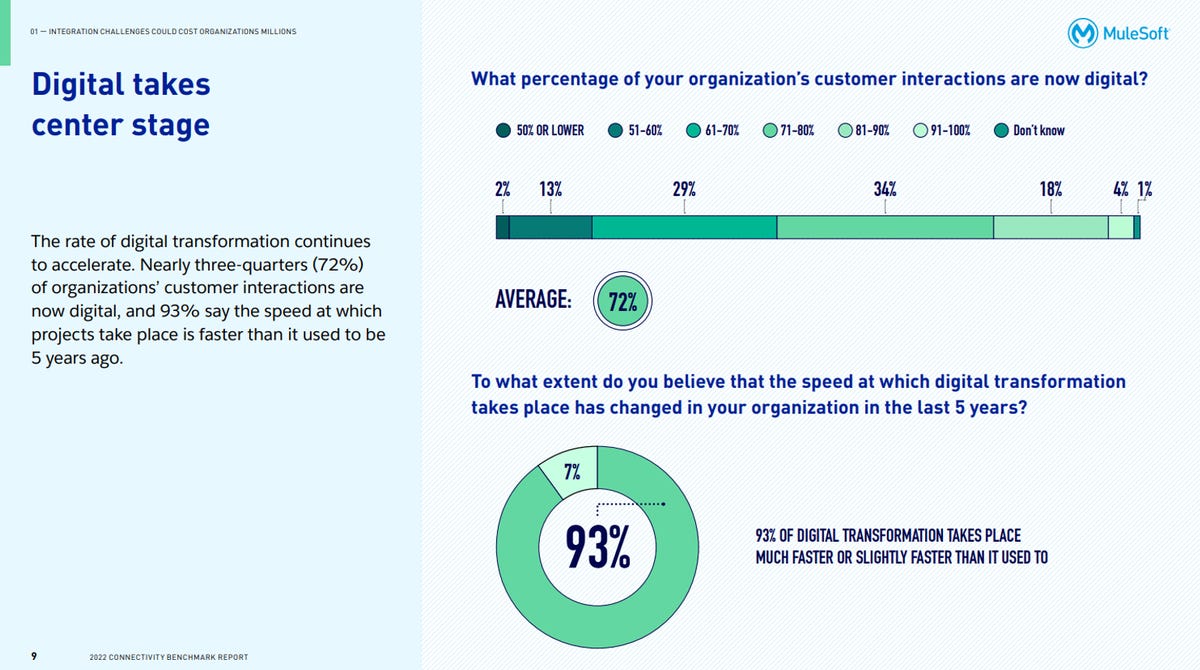
Digital takes center stage
2. The financial cost of slow digital transformation is significant: It’s calculated that they could lose on average nearly $7 million ($6,846,979) if they fail to successfully complete digital transformation initiatives.
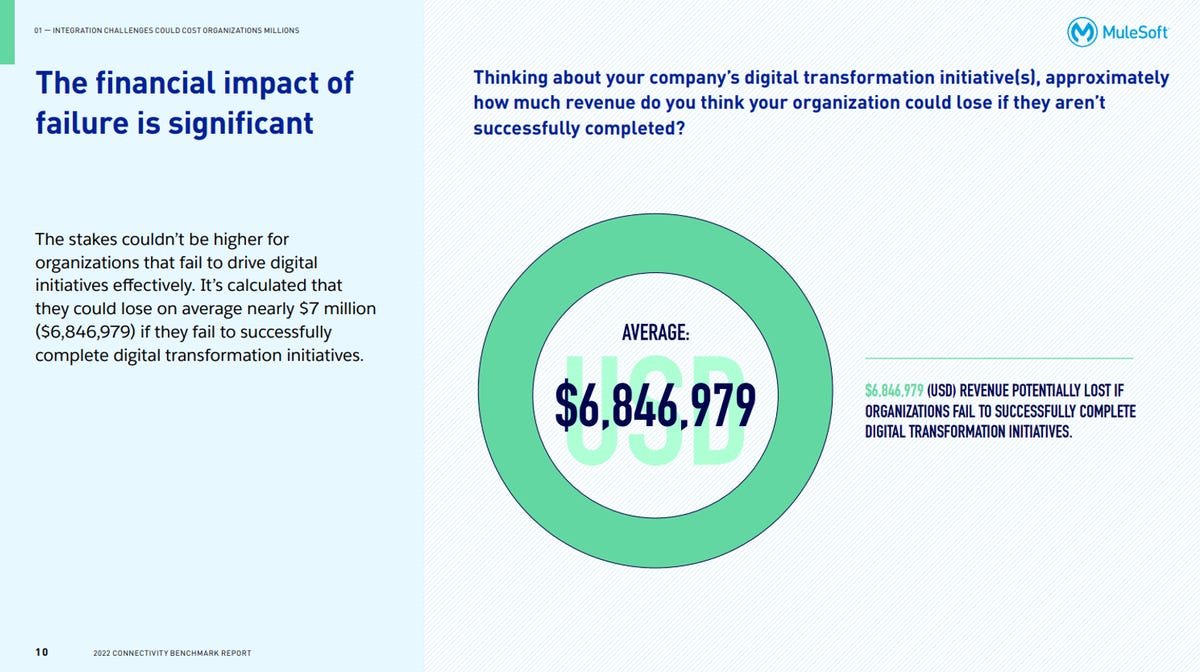
The business cost of slow digital transformation is significant
3. Adoption of apps is accelerating, but integration is falling behind: The average number an organization had this year was 976, a large increase from the figure a year ago (843). This could be an indication of growing shadow IT deployments in organizations during the pandemic. But more importantly, only 28% of these apps on average are integrated, down slightly from 29% in the 2021 report. The average lifetime for a typical application has also grown slightly to 4.1 years.

Apps are on the rise, but integration is not
4. Firms are spending too much on custom integration: On average, companies spent $3.65 million in custom integration labor in 2021 versus $3.5 million in the previous 12 months.
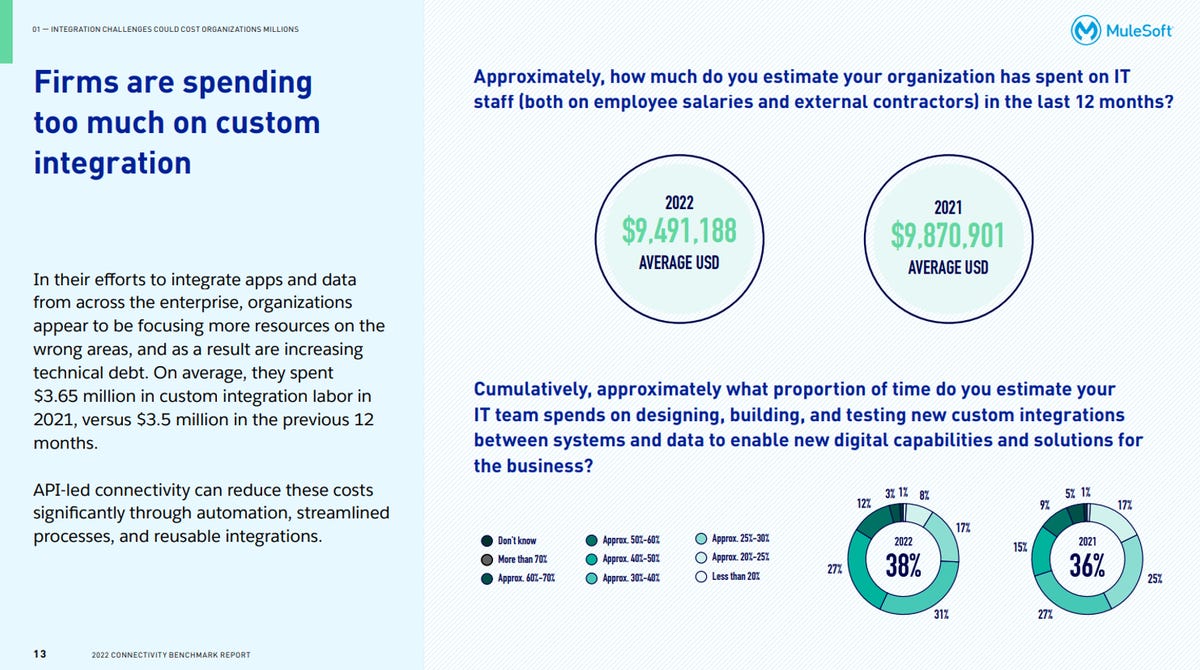
Firms are spending too much on custom integration: $9.5M in 2022
5. Data silos are persistent: Some 90% of respondents cite silos as a challenge, the same number as in the 2021 report, showing that little progress has been made in this crucial area.
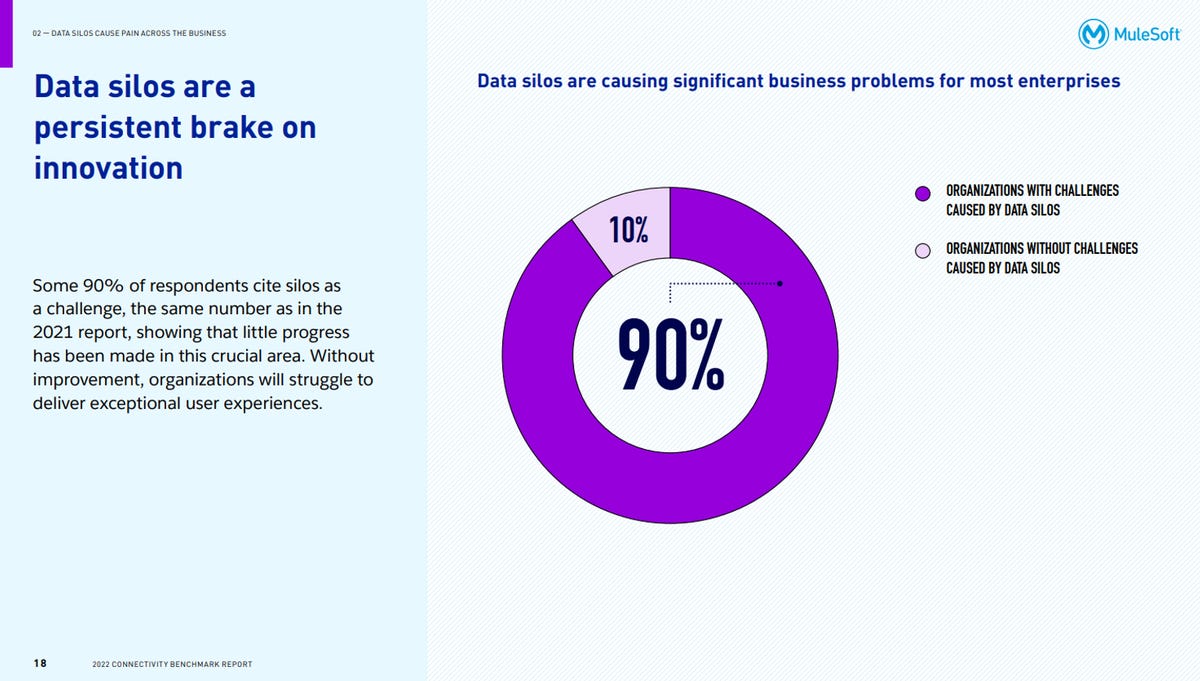
Data silos are causing significant business problems for most enterprises
6. Integration demands grow across the enterprise: Data scientists are most likely to have requirements for unlocking and integrating data (49%), followed by business analysts (44%), then customer support (42%).
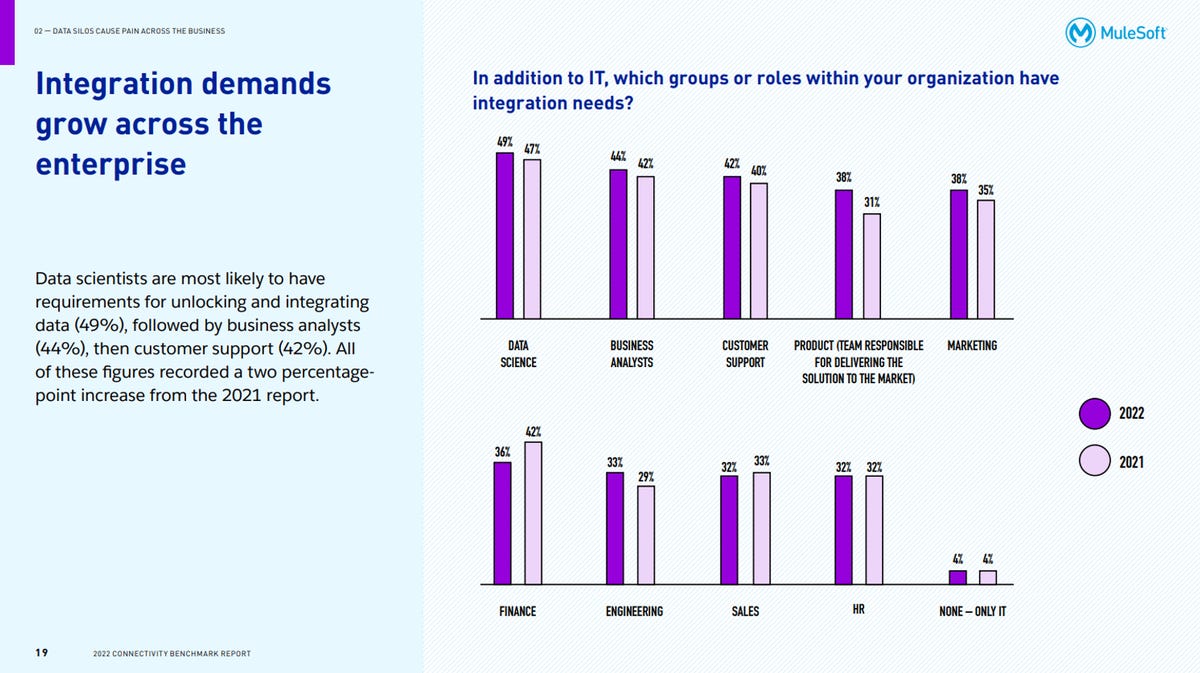
Integration demands grow across the enterprise
The most pronounced integration challenges were:
- Incorporating data-derived insights into user-facing applications (75%)
- Reusing data sources across different user-facing applications (73%)
- Correlating data in the warehouse to derive insights (71%)
- Moving data from source systems into the data warehouse (70%)
Also: Global research: 3 out of 4 professionals do not feel ready to work in a digital-first world
7. IT budgets continue to rise: 85% of responding organizations said this was true versus 77% in the 2021 report and 75% in the 2020 report. The number of projects IT is asked to deliver has increased by 40% in 2022, a jump from 30% in 2021. Over half (52%) of projects weren’t delivered on time last year.

IT budgets are up, but so is demand
8. IT is struggling to deliver on time: On average, 52% of projects weren’t delivered on time over the past 12 months. However, the good news is that IT is more likely to be completing all the projects asked of them than in the period covered by the 2021 report: 44% versus 37%.
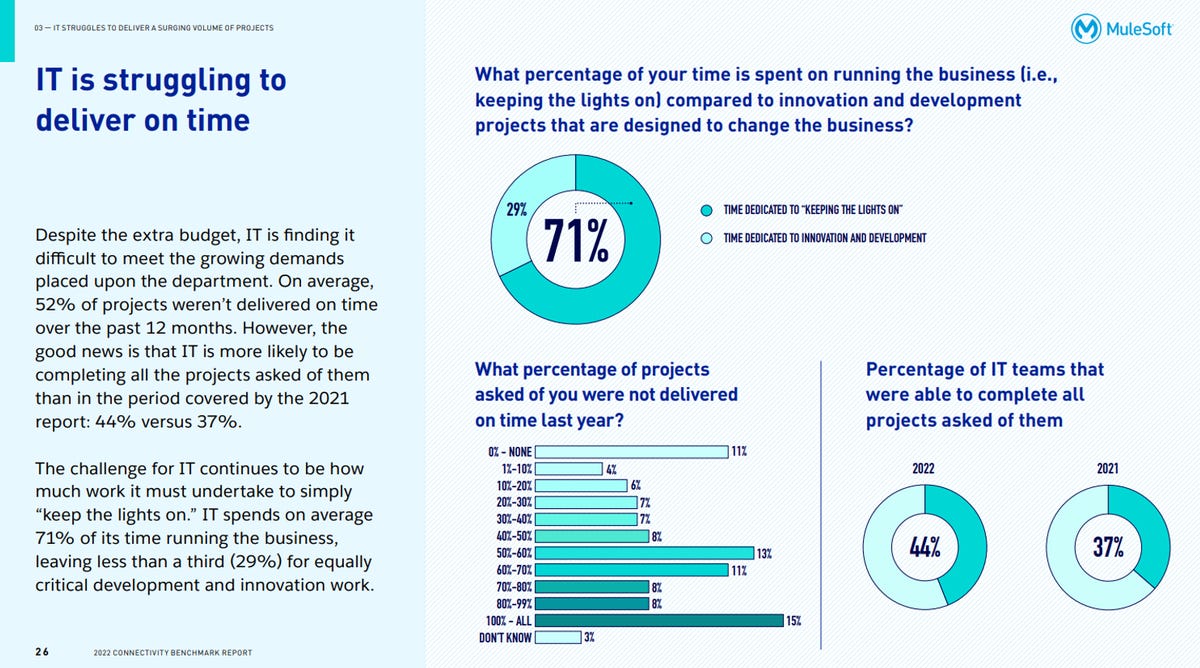
IT is struggling to deliver on time
9. Organizations find it harder to integrate user experiences: Over half (55%) of organizations are finding it difficult to integrate user experiences. Nearly a third (30%) of organizations are able to provide completely connected user experiences across all channels.
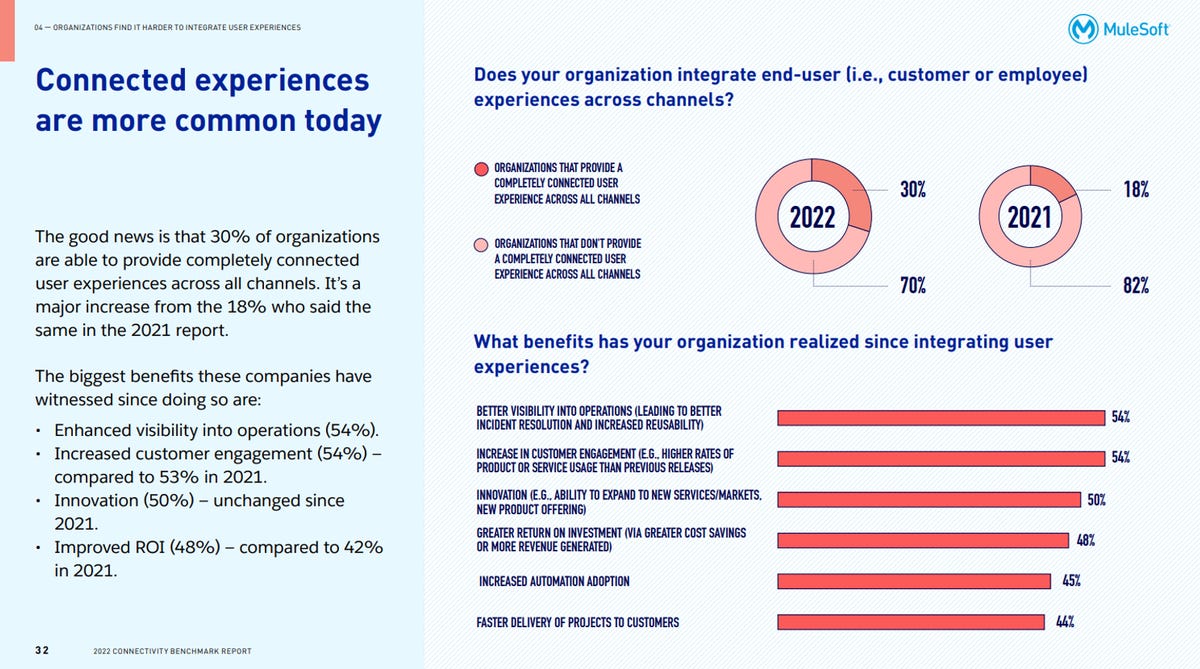
Connected experiences are more common today
10. Security and governance top integration challenges: Over half (55%) of organizations say it’s difficult to integrate user experiences, up from 48% a year ago. The biggest challenges are:
- Security and governance (54%)
- Outdated IT infrastructure (46%)
- An inability to keep up with ever-changing processes, tools, and systems (42%)
- Data silos (42%)
11. Leadership now mandates a company-wide API strategy: The vast majority (98%) of organizations now use APIs. The number who mandate a company-wide API integration strategy has surged to 26% from 15% just a year ago. Nearly half (46%) of internal software assets are available for reuse, and 55% of organizations have a mature or very mature strategy for non-technical users.
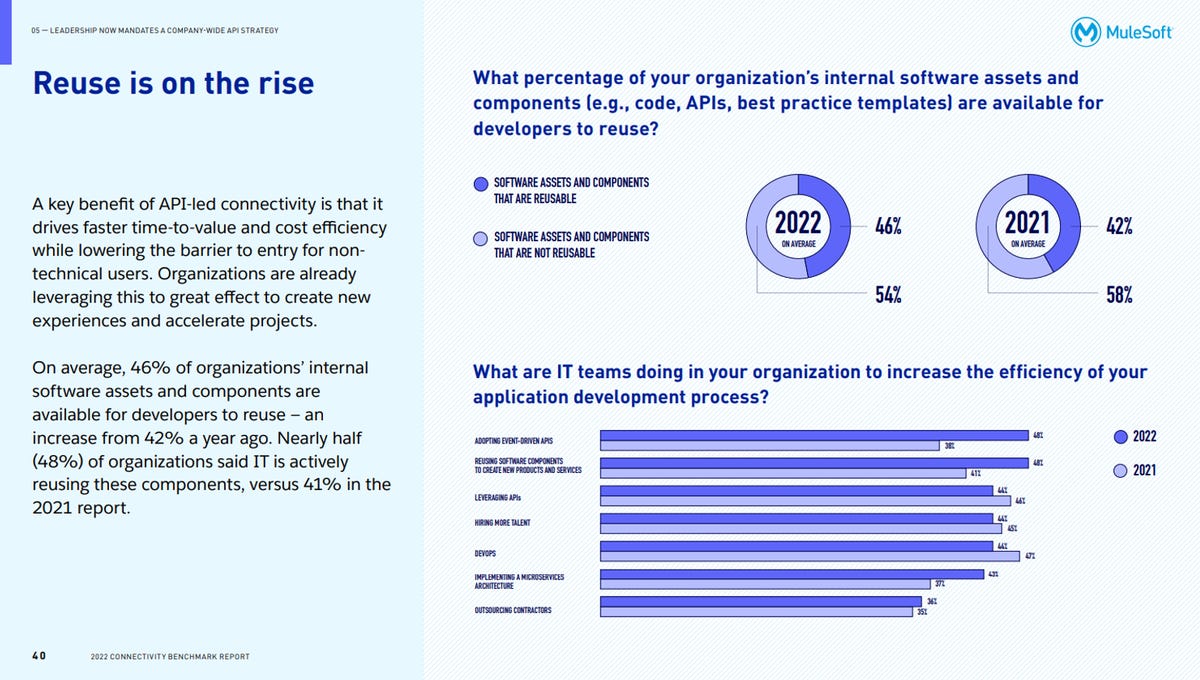
APIs are virtually ubiquitous in modern enterprises
12. APIs are helping organizations drive more value and revenue: APIs can unlock major revenue growth opportunities. Over a third (35%) of organizations’ revenue is now being generated by APIs and related implementations. Organizations are recognizing that the combination of API-led connectivity and automation can deliver better employee and customer experiences. A third (31%) of organizations plan to invest in robotic process automation (RPA), more than double the figure of a year ago.
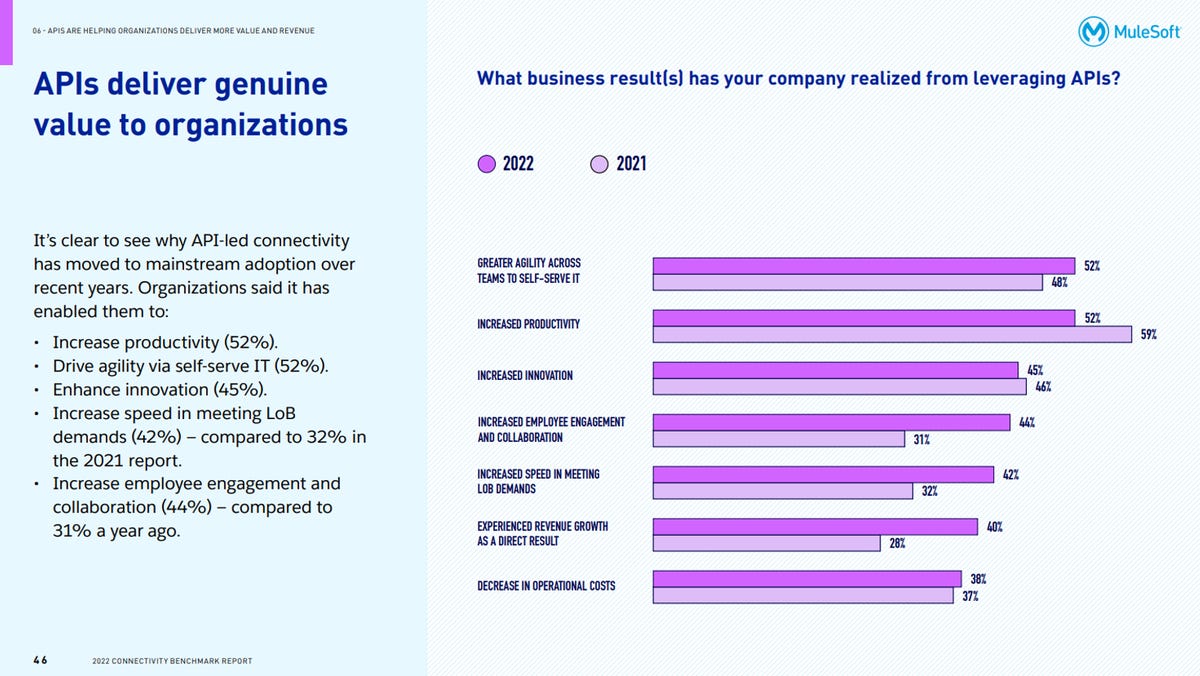
APIs deliver genuine value to organizations
Organizations said API-led connectivity has enabled them to:
- Increase productivity (52%)
- Drive agility via self-serve IT (52%)
- Enhance innovation (45%)
- Increase speed in meeting LoB demands (42%) — compared to 32% in the 2021 report
- Increase employee engagement and collaboration (44%) — compared to 31% a year ago
Also: Employee satisfaction increases as a result of automation in the workplace
13. Automation emerges as a key ingredient: Nearly a third (31%) of organizations plan to invest in robotic process automation (RPA), versus 13% a year ago. Most are currently managing this (67%) and tracking it (58%) centrally via IT. It is IT developers (72%) and IT operations (66%) who are most involved in automating business processes and tasks.

Automation emerges as a key ingredient
The report concludes that digital transformation has become a critical driver of customer engagement and employee productivity.
Here are the four recommendations for business leaders, according to the research findings:
- Empower business users IT departments are struggling to deliver all the projects required of them on time. To optimize your organization’s potential, accelerate the speed of digital transformation by handing low- and no-code tools to business technologists. They can then simply drag-and-drop components to create new integrated user experiences built on reusable APIs.
- Tackle security and governance challenges Security is an increasingly acute challenge for IT teams as they transition to API-led connectivity approaches. A serious incident could delay or even permanently derail transformation projects. Organizations should seek vendors that can provide multi-layered protection of the data itself, the API that provides access to it, and the perimeter within which the API is deployed.
- Focus on API reuse The era of point-to-point integrations is drawing to a close. In its place is a more flexible, agile, and cost-effective way to create the experiences your users and customers crave: reusable API-led integration. It’s faster, more cost-effective, and will mean less effort for IT and business users.
- Create a Single Source of Truth (SSOT) Data-driven organizations will increasingly pull ahead of the competition as the post-pandemic era unfolds. To join them, you must first break down longstanding data silos by creating an SSOT to ensure all users work from the same standardized, relevant data set. Then it’s about using API-led connectivity to turn this data into meaningful insight and innovative user experiences. The future awaits.
To learn more about MuleSoft’s 2022 Connectivity Benchmark Report, you can visit here.
For all the latest Technology News Click Here
For the latest news and updates, follow us on Google News.
